|
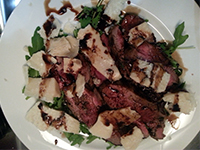 |
Tagliata di manzo con rucola.
(Italian steak with shaved parmesan,
on a bed of arugula, drizzled with balsamic vinegar) |

Grilled file mignon, medium rare. |
Imagine succulent slices of file mignon cooked medium-rare, seared on the outside and lush and moist on the inside,
resting on a bed of fresh rucola (arugula), covered by paper-thin shavings of pale yellow parmesan cheese,
drizzled with balsamic vinegar... Pair it with a glass of good red wine and perfection has been achieved!
This is a simple dish, but one that is perfection embodied in simplicity. Moreover, it is
an embodiment of the rich history of Italy going back all the way to the Roman times.
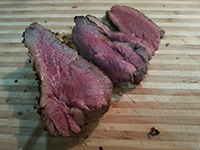
Grilled file mignon, medium rare. |
It is important to note several things, with the choice of meat being the first. There is a wide range
of beef recipes in Italian cuisine ranging from complex flavors such as
Ragù Alla Bolognese, to the quirky (Involtini di bresaola
with ricotta, pears and walnuts, or Beef carpaccio), to the
simple-yet-elegant (grilled steak with rosemary), to the simple (boiled beef with potatoes).
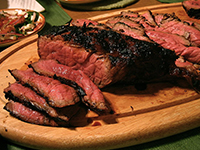
Flank steak. |
A steak in Italy is not always an individual slab of grilled meat. A tagliata is a nice,
thick piece of beef that is grilled, then carved. It is simple and delicious but impressive nevertheless.
Flank steak is good for its tastiness, but the meat can be tough if it not marinated and sliced thin.
In our opinion, other cuts such as sirloin or tenderloin are the best choices for this dish.
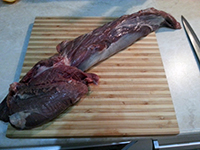
Whole tenderloin of beef. |
The tenderloin are the psoas major muscles found in the cow along both sides of the spine.
As they are not load-bearing muscles, they contain less connective tissue, which makes them
tender and tasty, and therefore desirable and expensive. A tenderloin has three parts:
the smaller pointy end, the middle portion, and the thick end. American butchers tend to
call the whole think "filet mignon". French butchers differentiate these cuts into tournedos
(the smaller central portion), châteaubriand (the larger central portion), and
tête de filet (head of the filet). We use the tête de filet for this recipe.
Purists season tagliata only with salt. Some recipes make it highly seasoned using
coarsely crushed black peppercorns, garlic and rosemary. We are staying with the purist
version, to allow the blend of arugula, the best balsamic vinegar and Parmigiano-Reggiano
cheese from Italy to come out.

Wild arugula plant. |
Second is the subject of the salad leaves. Arugula, as it is known in U.S., and rocket
as it is known in rocket Canadian, British, Australian, New Zealand and South African English,
is a plant of the species Eruca sativa. It has deeply pinnately lobed leaves with
4-10 small lateral lobes and a large terminal lobe. The flavor is strong, pungent and peppery.
The Italian name rucola is derived from the Latin eruca. It is a traditional
Mediterranean herb that has been grown in the area since the Roman times. It was mentioned
by various classical authors as an aphrodisiac, notably in a poem by Virgil. Beside this recipe,
it is used on pizza (Italy and Slovenia) or as an ingredient of the mesclun, which
is a salad mix from Provence.
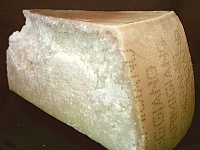
Parmigiano-Reggiano cheese from Italy. |
Third is the subject of Parmesan cheese. Original Parmigiano-Reggiano cheese from
Italy should be used before look-alikes from other places in the world are considered.
Parmigiano-Reggiano, a hard, granular cheese, comes from northern Italy, from the
provinces of Parma, Reggio Emilia, Bologna, Modena, and Mantova. Parmigiano is
the Italian adjective for Parma and Reggiano for Reggio Emilia. This is great cheese:
very natural and very delicious. It is wonderful by itself in chunks with wine, or grated
and mixed with balsamic vinegar as a starter or a snack, as well as shaved over or grated
into other dishes.
In American supermarkets, the terms "Parmesan" or "Italian hard cheese" are used for cheeses
made outside of the protected designated area of origin in Italy. In a store in the UK,
"Parmesan" means buying Parmigiano-Reggiano because under EU laws, the term "Parmesan"
cannot be used for cheeses made outside of the protected area of origin. One should be aware
that in an American store, "Parmesan" can mean anything because there are no such legal restrictions.
Parmigiano-Reggiano cheese is made of three simple ingredients: grass-fed milk from
the Parma-Reggio Emilia region, salt, and calf rennet (a natural enzyme). Mass-produced American
Parmesan, such as that from Kraft, are usually a loaded with other ingredients such as
cellulose powder, potassium sorbate and cheese cultures, which would be completely illegal
in the Italian Parmigiano-Reggiano. Mainstream American Parmesan also has a much higher
salt content and and less tang than Parmigiano-Reggiano. While Parmigiano-Reggiano
has been historically available in the U.S., those days may be over. As it is often unpasteurized,
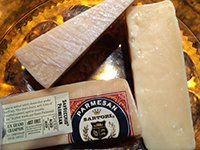
Parmesan cheese from Sartori Foods in Wisconsin. |
the FDA thinks that is a bad thing and Parmigiano-Reggiano may end up banned.
Fortunately, there are small American companies that do make Parmesan cheese that comes very
close to the Italian original. For example, Sartori Foods from Wisconsin, founded in 1939
by Paolo Sartori and Louis Rossini, Makes a Parmesan cheese where the only difference is
that the milk is from Wisconsin cows instead of Italian cows.
Parmigiano-Reggiano cheese dates back to at least the 13th and 14th centuries.
It is mentioned in Giovanni Boccaccio's "The Decameron" written in 1348.
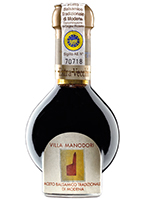
25-year Aceto Balsamico Tradizionale
di Modena DOP (Extra Vecchio) -
3.5-ounce bottle (100 ml), yours for
$260 at Amazon. |
Finally, there is the subject of Balsamic vinegar. Balsamic vinegar from Italy is not, by far,
the same as red wine vinegar used in French cuisine. True balsamic vinegar (or Aceto Balsamico
Tradizionale) is made from the juice of pressed Trebbiano and Lambrusco grapes that
have been aged for many years in wooden caskets. The minimum aging is for 12 years, and takes
place in a battery of seven barrels of successively smaller sizes. The casks are made of
different woods such as chestnut, acacia, cherry, oak, mulberry, ash and juniper. The result
is a rather thick syrup with a glossy, deep brown color, and a rich and complex flavor that
balances the natural sweet and sour elements of the cooked grapes with hints of wood from
the casks. It is often much more expensive than an average bottle of wine! Moreover,
it has been made like this since the 11th century.
In short, the difference between Aceto Balsamico Tradizionale and red wine vinegar
is about as profound as the difference between a fine Bordeaux and Welch's grape juice,
or for the gearheads out there, between a Ferrari 458 Italia and a Cinquecento.
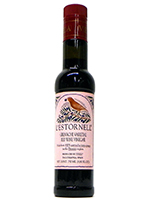
Red wine vinegar from Spain -
8.8-ounce bottle (250 ml), $10 at
Amazon. |
While balsamic vinegar is made from grapes, red wine vinegar is made from wine that has been
allowed to ferment and turn into a mixture of water and acetic acid. In practice, red wine
is allowed to ferment in the presence of air until it turns sour. Once the fermentation is
complete, a good red wine vinegar is aged up to two years. The longer the vinegar ages,
the more mellow the flavor becomes. As with wine, there is a considerable range in quality:
better-quality wine vinegars are made from individual varieties of wine, such as champagne,
sherry, or pinot gris. Red wine vinegars are made wherever wine is made: France, Spain,
Austria, even Italy. They can be tasty in their own right and belong in many sophisticated
recipes especially in French cuisine, but they are not in the same league as far as taste
as balsamic vinagers from Italy.
Only two areas produce true traditional balsamic vinegar: Modena and Reggio Emilia. Modena uses a
color code for its bottles to indicate grade of its Aceto Balsamico Tradizionale di Modena:
a white cap means the vinegar has aged for at least 12 years, and a gold cap means the vinegar
has aged for 25 years or more. Reggio Emilia uses a different system for its Aceto Balsamico
Tradizionale di Reggio Emilia using label color: a red label means a 12-year old vinegar,
a silver label means an 18-year vinegar, and a gold label means 25 years or more.

Table grade Aceto Balsamico di Modena
8.8-ounce (250 ml) bottle for $33
at Amazon. |
Aceto Balsamico di Modena (lacking the designation Tradizionale) is relatively
inexpensive substitute made from regular red wine vinegar, fruit juice and additional colorings
such as caramel and thickeners such as guar gum or cornflour, to simulate the sweetness and
thickness of the aged Aceto Balsamico Tradizionale.
This recipe underscores the fact that many of the best things in life do come from northern
Italy. Within a relatively small area, the cities of Cremona, Maranello, Sant'Agata Bolognese,
Modena and Parma have been the birthplaces of such things as Guarnieri and Stradivari violins,
Ferrari and Lamborghini cars, Parma ham, Parmesan cheese, and balsamic vinegar.

Tagliata di manzo con rucola
Ingredients:
- Coarse sea salt
- 500 g (1 lb) tenderloin steak (tête de filet), whole
- Parmigiano-Reggiano cheese, shaved into paper thin shavings
- 1 bunch of arugula (rocket, rucola), washed and dried on paper towels
- Drippings of genuine Balsamic vinegar
- YIELD: Serves 4
Preparation:
- Heat a grill pan and throw in some coarse sea salt. This will add flavor to the
meat.
- Grill the meat on both sides until meadium-rare. This depends on the thickness
of the steak, about 5 minutes per side.
- Transfer the meat onto a cutting board and slice into slices approximately 1/4
inches in thickness, similar to English roast beef.
- On each plate, arrange a bed of arugula, then add a layer of the sliced beef.
Cover with a layer of the saved Parmigiano-Reggiano, and drizzle with a little
of the balsamic vinegar.
- Serve and enjoy.
back to Radim and Lisa's Well-Travelled Cookbook | email us
Last updated: October 31, 2014
Some photographs from Wikimedia Commons, used under the terms of the GNU Free Documentation License.
|











